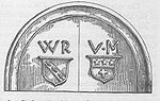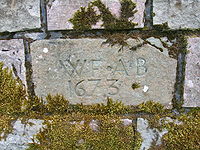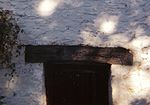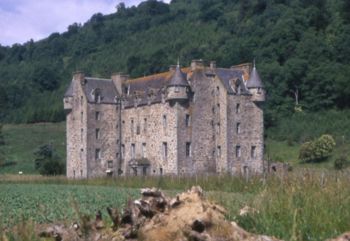
Marriage stone
Encyclopedia
A marriage stone is usually a stone lintel
carved with the initials, coat of arms
, etc. of a newly married couple with the date of the marriage. They were very popular until Victorian times, but fell out of general use in the 20th century. Many survive due to their having been carved in stone or wood and because they are part of, or they are in the grounds of listed and therefore protected buildings.
 Marriage stones serve as a record of a marriage, especially important in aristocratic families and also sometimes practiced amongst the newly established and monied middle classes. They were sometimes added to a building which was constructed specifically as the new family home for the married couple, especially when the dowry was large, or were carved into a pre-existing lintel. The stones also clearly indicated the ownership of the building to onlookers at the time as well as serving as a record for posterity of both marital bliss and often also of social advancement.
Marriage stones serve as a record of a marriage, especially important in aristocratic families and also sometimes practiced amongst the newly established and monied middle classes. They were sometimes added to a building which was constructed specifically as the new family home for the married couple, especially when the dowry was large, or were carved into a pre-existing lintel. The stones also clearly indicated the ownership of the building to onlookers at the time as well as serving as a record for posterity of both marital bliss and often also of social advancement.
Datestone
s are a subtly different category in that they primarily commemorate the construction of a building rather than record a marriage. They may do both and such symbolism as entwined hearts indicates that they serve to perform both functions. Datestones are far more common than Marriage stones and are found on most types of vernacular buildings, indeed they are in vogue again today (2007), partly through the influence of the significance of the 2000 millennium
year. Some buildings have both Marriage stones and datestones, such as 'The Hill' at Dunlop
, which has a date stone on the 'mansion house' and even the gateposts are dated.
of the
two families, just those of the husband and very rarely the combined coats of arms of both families. In some cases the adornment was religious in nature, such as at 'The Hill' farm mansion house (see photograph) or an artistic design simply placed there as an ornamentation. The designs are found cut into the stone or standing proud of the rock face. Originally some of these stones would have been brightly painted and adorned with gilt.
Marriage Stones


 A two ton Scottish granite
A two ton Scottish granite
Marriage stone was created for the wedding of Prince Charles and Camilla Parker-Bowles, 9 April 2005. Unusually this has carvings on both sides.
s in Germany
were constructed with a built-in 'treustein', or "marriage stone" at a corner of the structure facing the inner synagogue courtyard, which bore the initial Hebrew letters of the appropriate verse from Jeremiah, i.e. God's blessing to Abraham: "I will greatly bless you, and I will exceedingly multiply your children as the stars in heaven.". In these communities, the culmination of the marriage ceremony was marked by the groom throwing a glass goblet and shattering it at the 'treustein'.
's marriage ceremony the bride stands on a stone to symbolise her commitment to the marriage during times of difficulty and the couple walk seven times round the sacred fire reciting a prayer at each stage.
in County Antrim
, Northern Ireland
, sits a Bronze Age standing stone or 'holestone'. It is 1.5 metres high, with a 10 cm diameter hole cut into it. It is not known why the Holestone was created, but has attracted visitors seeking external love and happiness since at least the 18th century. Upon reaching the Holestone couples undertake a traditional ceremony where the woman reaches her hand through the circular hole and her partner takes it, thus pledging themselves to love each other forever. There is a legend regarding a black horse that inhabits the field in which the holestone is situated. According to this legend a young couple were married at the stone, but the groom committed an act of adultery on their wedding night. For this act he was cursed by the stone to spend eternity as a horse, never dying, and never able to leave that field.
Lintel (architecture)
A lintel can be a load-bearing building component, a decorative architectural element, or a combined ornamented structural item. It is often found over portals, doors, and windows.-Structural uses:...
carved with the initials, coat of arms
Coat of arms
A coat of arms is a unique heraldic design on a shield or escutcheon or on a surcoat or tabard used to cover and protect armour and to identify the wearer. Thus the term is often stated as "coat-armour", because it was anciently displayed on the front of a coat of cloth...
, etc. of a newly married couple with the date of the marriage. They were very popular until Victorian times, but fell out of general use in the 20th century. Many survive due to their having been carved in stone or wood and because they are part of, or they are in the grounds of listed and therefore protected buildings.
Purpose

Datestone
Datestone
A datestone is typically an embedded stone with the date of engraving and other information carved into it. They are not considered a very reliable source for dating a house, as instances of old houses being destroyed and rebuilt have been reported.Specific locations have often been chosen for...
s are a subtly different category in that they primarily commemorate the construction of a building rather than record a marriage. They may do both and such symbolism as entwined hearts indicates that they serve to perform both functions. Datestones are far more common than Marriage stones and are found on most types of vernacular buildings, indeed they are in vogue again today (2007), partly through the influence of the significance of the 2000 millennium
Millennium
A millennium is a period of time equal to one thousand years —from the Latin phrase , thousand, and , year—often but not necessarily related numerically to a particular dating system....
year. Some buildings have both Marriage stones and datestones, such as 'The Hill' at Dunlop
Dunlop, East Ayrshire
Dunlop is a village and parish in East Ayrshire, Scotland. It lies on the A735, north-east of Stewarton, seven miles from Kilmarnock. The road runs on to Lugton and the B706 enters the village from Beith.-The village:...
, which has a date stone on the 'mansion house' and even the gateposts are dated.
Positioning
The stones were placed where they would be easily and frequently seen by visitors, usually on the lintel above the front door of a house or in a prominent position facing the entrance or in the gardens, such as above a doorway in wall.Design
Usually carved into stone or sometimes wood, they can be very detailed, with usually only the initials of the married couple, the date of the marriage and sometimes the Coat of armsCoat of arms
A coat of arms is a unique heraldic design on a shield or escutcheon or on a surcoat or tabard used to cover and protect armour and to identify the wearer. Thus the term is often stated as "coat-armour", because it was anciently displayed on the front of a coat of cloth...
of the
two families, just those of the husband and very rarely the combined coats of arms of both families. In some cases the adornment was religious in nature, such as at 'The Hill' farm mansion house (see photograph) or an artistic design simply placed there as an ornamentation. The designs are found cut into the stone or standing proud of the rock face. Originally some of these stones would have been brightly painted and adorned with gilt.
Marriage Stones
Scotland

- Aiket Castle, DunlopDunlop, East AyrshireDunlop is a village and parish in East Ayrshire, Scotland. It lies on the A735, north-east of Stewarton, seven miles from Kilmarnock. The road runs on to Lugton and the B706 enters the village from Beith.-The village:...
, East Ayrshire – At Aiket, the stone is set into the wall of a building which was latterly a timber mill is a very worn marriage stone. - Albion House, CromartyCromartyThe Royal Burgh of Cromarty is a burgh in Ross and Cromarty, Highland, Scotland.-History:It was previously the county town of the former county of Cromartyshire...
, Ross and CromartyRoss and CromartyRoss and Cromarty is a variously defined area in the Highlands and Islands of Scotland. There is a registration county and a lieutenancy area in current use...
– situated in the garden of Albion House and originally from a house which was situated between Albion House and No 49 Church Street (Waterloo House) whose site is now part of the Garden of Albion House. It was demolished in the early 20th century after a fire in the late 19th century but was built by Donald Junor and Katrin (or Katherine) Gally who married in 1710. - Albion House, CromartyCromartyThe Royal Burgh of Cromarty is a burgh in Ross and Cromarty, Highland, Scotland.-History:It was previously the county town of the former county of Cromartyshire...
, Ross and CromartyRoss and CromartyRoss and Cromarty is a variously defined area in the Highlands and Islands of Scotland. There is a registration county and a lieutenancy area in current use...
– the above mentioned Donald Junor may be connected to the Andrew or Alexander Junor whose marriage stone was found built into the Courthouse. - Bogflat, StewartonStewartonStewarton is a town in East Ayrshire, Scotland. In comparison to the neighbouring towns of Kilmaurs, Fenwick, Dunlop and Lugton, it is a relatively large town, with a population of over 6,500. It is 300 feet above sea level.Groome, Francis H. . Ordnance Gazetteer of Scotland. Pub. Caxton. London....
, East Ayrshire – now in the Stewarton Museum, the BogflatChapeltounChapeltoun is an estate on the banks of the Annick Water in East Ayrshire, Scotland. This is a rural area famous for its milk and cheese production and the Ayrshire or Dunlop breed of cattle.-Templeton and the Knights Templar:...
stone is dated 1711 with a 'JR' carved into it and the other initials unfortunately cut off. - Castle of Park, Cornhill, Aberdeenshire – the dining room has an early 18th-century 'marriage stone' set into one wall.
- The Cuff, Gateside, North AyrshireNorth AyrshireNorth Ayrshire is one of 32 council areas in Scotland with a population of roughly 136,000 people. It is located in the south-west region of Scotland, and borders the areas of Inverclyde to the north, Renfrewshire to the north-east and East Ayrshire and South Ayrshire to the East and South...
– M Gibson & I Gibson, 1767. - Craigdarroch House, Moniave, Dumfries & Galloway – Robert Fergusson, married Lady Janet Cunningham, daughter of the 4th Earl of Glencairn of Maxwelton, in 1537 and their marriage stone, with the shakefork of the Cunninghams, is to be seen at CraigdarrochCraigdarrochCraigdarroch is the name of a house near Moniaive, Dumfries and Galloway, Scotland. It was the seat of the Chief of the Dumfriesshire Fergussons for 600 years.Built by William Adam in 1729 over the old house dating from the earliest records ....
with the other carved stones on the base of the old tower. - Fullarton House, TroonTroonTroon is a town in South Ayrshire. It is situated on the west coast of Scotland, about eight miles north of Ayr and three miles northwest of Glasgow Prestwick International Airport. Lying across the Firth of Clyde, the Isle of Arran can be seen. Troon is also a port with freight and ferry services...
– set in a plinth after the house was demolished. Anne Brisbane and William Fullarton 1673. - The Hill, DunlopDunlop, East AyrshireDunlop is a village and parish in East Ayrshire, Scotland. It lies on the A735, north-east of Stewarton, seven miles from Kilmarnock. The road runs on to Lugton and the B706 enters the village from Beith.-The village:...
, East Ayrshire – The HillDunlop cheeseDunlop is a mild cheese or 'sweet-milk cheese' from Dunlop in East Ayrshire, Scotland. It resembles a soft Cheddar cheese in texture. It fell out of popularity some time after the end of the Second World War, however it has now appreciated for its value in various recipes and for eating on its own...
stone is now placed above an internal window in the original farmhouse, but it, may have been moved or the building substantially altered. It reads '16 ID & BG 92' in old characters ('I' for 'J'). This commemorates the marriage of John Dunlop and Barbara Gilmour of Dunlop cheeseDunlop cheeseDunlop is a mild cheese or 'sweet-milk cheese' from Dunlop in East Ayrshire, Scotland. It resembles a soft Cheddar cheese in texture. It fell out of popularity some time after the end of the Second World War, however it has now appreciated for its value in various recipes and for eating on its own...
fame. A Brown family marriage stone is also present on a lintel entering the old farmhouse. - The Hill, Dunlop, East Ayrshire – the initials 'AB' and 'JA' positioned over the entrance to The HillDunlop cheeseDunlop is a mild cheese or 'sweet-milk cheese' from Dunlop in East Ayrshire, Scotland. It resembles a soft Cheddar cheese in texture. It fell out of popularity some time after the end of the Second World War, however it has now appreciated for its value in various recipes and for eating on its own...
'mansion house' together with the motto "Delights and Adorns" and a Bible held in a hand held upright, suggesting both Northern Ireland and Protestantism. The 'AB' stands for Andrew Brown, grandson of Barbara and John. He married 'JA', Jean Anderson, daughter of Matthew Anderson of Craighead, which they later inherited. As 'well to do' farmers they may have built the 'mansion house' at the 'The Hill', converting the old farm into a dairy and byre, however the window above is 'off centre', suggesting an adaptation. - Knockshinnoch Farm, New CumnockNew CumnockNew Cumnock is a place in East Ayrshire, Scotland. It expanded during the coal mining era but, like so many others, suffered after the deep shaft pits closed in the 1980's...
, East Ayrshire – in the byre, which may be the original farmhouse is a stone with the date 1691 and the initials HD and MC, a heart with what appears to be a dagger in it, a small star and a stags head. - Lude, Blair AthollBlair AthollBlair Atholl is a small town in Perthshire, Scotland, built about the confluence of the Rivers Tilt and Garry in one of the few areas of flat land in the midst of the Grampian Mountains. The Gaelic place-name Blair, from blàr, 'field, plain', refers to this location...
, PitlochryPitlochryPitlochry , is a burgh in the council area of Perth and Kinross, Scotland, lying on the River Tummel. Its population according to the 2001 census was 2,564....
– the Marriage stone of Alexander Robertson 10th of Lude and Katherine Campbell daughter of Glenorchy. - Mains of Giffen, BarrmillBarony and Castle of GiffenThe Barony of Giffen and its associated 15th-century castle were in the parish of Beith in the former District of Cunninghame, now North Ayrshire. The site may be spelled Giffen or Giffin and lay within the Lordship of Giffin, which included the Baronies of Giffen, Trearne, Hessilhead, Broadstone,...
, North Ayrshire – 'RC MC 1758' on a lintel in the old farm buildings. - Castle Menzies, WeemWeemWeem is a village on the B846 near Aberfeldy in Perthshire, Scotland.The name Weem is derived from the Gaelic uaimh, meaning 'cave'....
, PerthshirePerthshirePerthshire, officially the County of Perth , is a registration county in central Scotland. It extends from Strathmore in the east, to the Pass of Drumochter in the north, Rannoch Moor and Ben Lui in the west, and Aberfoyle in the south...
– A marriage stone faces the entrance, installed by James Menzies in 1571 to record his marriage to Barbara Stewart, daughter of the Earl of Atholl. - Parkhill House, DalryDalryDalry is the name of several places in Scotland:* Dalry, North Ayrshire* Dalry, Edinburgh* St. John's Town of Dalry You may also be looking for Dalrigh or the Battle of Dalrigh...
– 'JR1732JR', probably the 'Reid' family. - Robertland House, Dunlop, East AyrshireEast AyrshireEast Ayrshire is one of 32 council areas of Scotland. It borders on to North Ayrshire, East Renfrewshire, South Lanarkshire, South Ayrshire and Dumfries and Galloway...
– placed above a door leading into the formal gardens. - Rowallan Castle, KilmaursKilmaursKilmaurs is a village in East Ayrshire, Scotland. It lies on the Carmel, 21.1 miles south by west of Glasgow. Population recorded in 2001 Census, 2601- History :...
, East Ayrshire. At Rowallan CastleRowallan CastleRowallan Castle is an ancient castle located near Kilmaurs, at NS 4347 4242, about north of Kilmarnock, East Ayrshire, Scotland. The castle stands on the banks of the Carmel Water, which may at one time have run much closer to the low eminence upon which the original castle stood, justifying the...
is a stone marked with Jon.Mvr. M.Cvgm. Spvsis 1562. - Townhead of LambroughtonLambroughtonLambroughton is a village in the old Barony of Kilmaurs, North Ayrshire, Scotland. This is a rural area famous for its milk and cheese production and the Ayrshire or Dunlop breed of cattle.-Origins of the name:...
, Stewarton, East Ayrshire – a marriage stone is now built into a wall on the farm . It reads 'AL MR 1707'. The 'AL' may stand for Alexander Langmuir. The stone came from a contemporary building which was demolished in the late 20th century. - Woodside House, Parish of BeithBeithBeith is a small town situated in the Garnock Valley in North Ayrshire, Scotland approximately 20-miles south-west of Glasgow. The town is situated on the crest of a hill and was known originally as the "Hill o' Beith" after its Court Hill.-History:-Name:Beith's name is thought to emanate from...
– a stone built into the corner of a gable with "G. 1759 R," and "A. 1759 P.". This is for Gavin Ralston of that Ilk, and his spouse Anabella, daughter of James Pollock of Arthurlee. Another has "W.C.P." and "A.C.P." and underneath it are the initials and date, "W. 1845 P.", which is for William Charles Sochran-Patrick and his spouse. Finally, a pediment stone in Roman style has "W.R." and "U.M." for William Ralston of that Ilk, and his spouse, Ursula, daughter of William Muir of Glanderstoun, by Jean, daughter of Mr. Hans Hamilton, Vicar of DunlopDunlop, East AyrshireDunlop is a village and parish in East Ayrshire, Scotland. It lies on the A735, north-east of Stewarton, seven miles from Kilmarnock. The road runs on to Lugton and the B706 enters the village from Beith.-The village:...
.
Wales

- Penybenglog House, Nevern, South Wales – A wooden lintel used as a marriage 'stone'. Dated 1523, 'WG' & 'RS'.
Ireland
- Killimor castle – the "Marriage Stone" of Teige O'Daly (eldest son of Dermot who died 1614) and Sisily O'Kelly. The stone was returned from LusmaghLusmaghLusmagh is an area and townland in County Offaly, Ireland. It is also a Roman Catholic parish, in the Diocese of Clonfert, the only one east of the River Shannon.-People:...
(near Cloghan Castle, Co. Offaly) to KillimordalyKillimordalyKillimorbaby is a village and parish in County Galway, Ireland. It was originally located in Brian Burkes house Shkyboyhouse.-See also:* Íomar of the Sogain* List of towns and villages in Ireland-External links:*...
Churchyard in 1980. The stone was originally inserted above the entrance to Killimor Castle in commemoration of the castle's construction in 1624 where it remained during the various reconstructions of "The Castle" to a more comfortable type of residence during the 18 th. and 19 th. centuries. Teige and Sisily Daly's line became extinct, circa 1820.
Jersey
- Penryn Farm, Bechet es Cats, St. JohnSaint John, JerseySaint John is one of the twelve parishes of Jersey in the Channel Islands.-Geography:Saint John is in the north of Jersey and borders St Mary on its west, Trinity to the east, and St Lawrence and Saint Helier on its south....
– marriage stone “1884”.
Modern marriage stones

Granite
Granite is a common and widely occurring type of intrusive, felsic, igneous rock. Granite usually has a medium- to coarse-grained texture. Occasionally some individual crystals are larger than the groundmass, in which case the texture is known as porphyritic. A granitic rock with a porphyritic...
Marriage stone was created for the wedding of Prince Charles and Camilla Parker-Bowles, 9 April 2005. Unusually this has carvings on both sides.
The Treustein
Many synagogueSynagogue
A synagogue is a Jewish house of prayer. This use of the Greek term synagogue originates in the Septuagint where it sometimes translates the Hebrew word for assembly, kahal...
s in Germany
Germany
Germany , officially the Federal Republic of Germany , is a federal parliamentary republic in Europe. The country consists of 16 states while the capital and largest city is Berlin. Germany covers an area of 357,021 km2 and has a largely temperate seasonal climate...
were constructed with a built-in 'treustein', or "marriage stone" at a corner of the structure facing the inner synagogue courtyard, which bore the initial Hebrew letters of the appropriate verse from Jeremiah, i.e. God's blessing to Abraham: "I will greatly bless you, and I will exceedingly multiply your children as the stars in heaven.". In these communities, the culmination of the marriage ceremony was marked by the groom throwing a glass goblet and shattering it at the 'treustein'.
Hindu weddings
In the HinduHindu
Hindu refers to an identity associated with the philosophical, religious and cultural systems that are indigenous to the Indian subcontinent. As used in the Constitution of India, the word "Hindu" is also attributed to all persons professing any Indian religion...
's marriage ceremony the bride stands on a stone to symbolise her commitment to the marriage during times of difficulty and the couple walk seven times round the sacred fire reciting a prayer at each stage.
Holed stones
On the crest of a hill near the village of DoaghDoagh
Doagh is a village and townland in County Antrim, Northern Ireland. It is in the Six Mile Water Valley about two miles southwest of Ballyclare. It had a population of 1,130 people in the 2001 Census....
in County Antrim
County Antrim
County Antrim is one of six counties that form Northern Ireland, situated in the north-east of the island of Ireland. Adjoined to the north-east shore of Lough Neagh, the county covers an area of 2,844 km², with a population of approximately 616,000...
, Northern Ireland
Northern Ireland
Northern Ireland is one of the four countries of the United Kingdom. Situated in the north-east of the island of Ireland, it shares a border with the Republic of Ireland to the south and west...
, sits a Bronze Age standing stone or 'holestone'. It is 1.5 metres high, with a 10 cm diameter hole cut into it. It is not known why the Holestone was created, but has attracted visitors seeking external love and happiness since at least the 18th century. Upon reaching the Holestone couples undertake a traditional ceremony where the woman reaches her hand through the circular hole and her partner takes it, thus pledging themselves to love each other forever. There is a legend regarding a black horse that inhabits the field in which the holestone is situated. According to this legend a young couple were married at the stone, but the groom committed an act of adultery on their wedding night. For this act he was cursed by the stone to spend eternity as a horse, never dying, and never able to leave that field.

